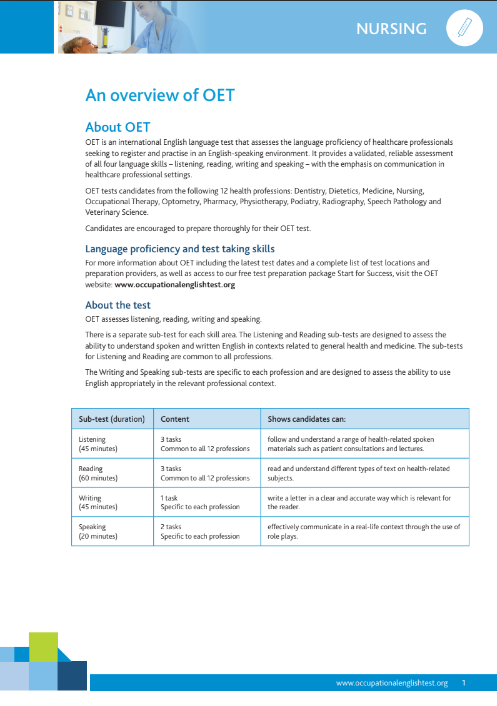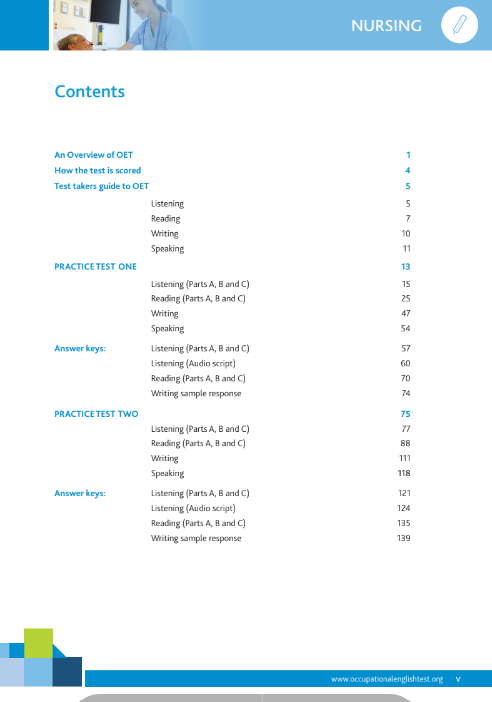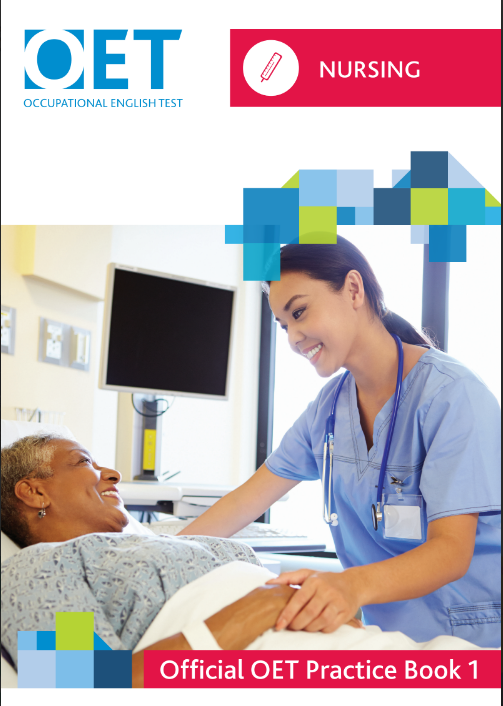


**An overview of OET** **About OET** OET is an international English language test that assesses the language proficiency of healthcare professionals seeking to register and practise in an English-speaking environment. It provides a validated, reliable assessment of all four language skills: Listening, Reading, Writing and Speaking – with the emphasis on communication in healthcare professional settings. OET tests candidates from the following 12 health professions: Dentistry, Dietetics, Medicine, Nursing, Occupational Therapy, Optometry, Pharmacy, Physiotherapy, Podiatry, Radiography, Speech Pathology and Veterinary Science. Candidates are encouraged to prepare thoroughly for their OET test. **Language proficiency and test taking skills** For more information about OET including the latest test dates and a complete list of test locations and preparation providers, as well as access to our free test preparation package Start for Success, visit the OET website: www.occupationalenglishtest.org **About the test** OET assesses Listening, Reading, writing and speaking. There is a separate sub-test for each skill area. The Listening and Reading sub-tests are designed to assess the ability to understand spoken and written English in contexts related to general health and medicine. The sub-tests for Listening and Reading are common to all 12 professions. The Writing and Speaking sub-tests are specific to each profession and are designed to assess the ability to use English appropriately in the relevant professional context. | Sub-test (duration) | Content | Shows candidates can: | |—|—|—| | Listening (45 minutes) | 3 tasks <br> Common to all 12 professions | follow and understand a range of health-related spoken materials such as patient consultations and lectures. | | Reading (60 minutes) | 3 tasks <br> Common to all 12 professions | read and understand different types of text on health-related subjects. | | Writing (45 minutes) | 1 task <br> Specific to each profession | write a letter in a clear and accurate way which is relevant for the reader | | Speaking (20 minutes) | 2 tasks <br> Specific to each profession | effectively communicate in a real-life context through the use of role plays. | **Listening subtest** The Listening sub-test consists of three parts, and a total of 42 question items. You will hear each recording once, and you are expected to write your answers while listening. All three parts take 45 minutes to complete. The Listening sub-test has the following structure: **Part A – consultation extracts** Part A assesses your ability to identify specific information during a consultation. You will listen to two five-minute professional healthcare-patient consultations and you will complete the health professional-patient notes using the information you hear. **Part B – short workplace extracts** Part B assesses your ability to identify the gist, detail, opinion or purpose of short extracts from the healthcare workplace. You will listen to one six-minute short extracts (e.g. team briefings, handovers, or health professional-patient dialogues) and you will answer one multiple-choice question for each extract. **Part C – presentation extracts** Part C assesses your ability to follow a recorded presentation or interview on a range of accessible healthcare topics. You will listen to two different five-minute extracts and you will answer six multiple-choice questions for each extract. **Reading subtest** The Reading sub-test consists of three parts, with a total of 42 question items. You are given 60 minutes to complete all three parts (15 minutes for Part A and 45 minutes for Part B and Part C). The Reading sub-test has the following structure: **Part A – expeditious reading task** Part A assesses your ability to locate specific information from four short texts in a quick and efficient manner. You must answer 20 questions in the allocated time period. The 20 questions consist of matching, sentence completion and short answer questions. **Part B and Part C – careful reading tasks** Part B assesses your ability to identify the detail, gist or purpose of six short texts sourced from the healthcare workplace. The texts might consist of extracts from policy documents, hospital guidelines, manuals or internal communications, such as email or memos. For each text, there is one three-option multiple-choice question. Part C assesses your ability to identify detailed meaning and opinion in two texts on a topic of healthcare professionals (800 words each). For each text, you must answer eight four-option multiple-choice questions. **Writing subtest** The Writing sub-test consists of one profession specific task based on a typical workplace situation. The writing test takes 45 minutes to complete – 40 minutes to write your letter and 5 minutes at the start to read the case notes on which to base your writing. The Writing sub-test has the following structure: The task is to write a letter, usually a referral letter but sometimes a different type of letter such as a letter of transfer or discharge, or a letter to advise or inform a patient, carer, or group. Along with the task instructions, you will receive stimulus material (case notes and/or other related documentation) which includes information to use in your response. **Speaking subtest** The Speaking sub-test consists of two profession specific role-plays and is delivered individually. It takes around 20 minutes to complete. In each role-play, you take your professional role (for example, as a nurse or as a pharmacist) while the interlocutor plays a patient, a client, or a relative of the patient. For veterinary science, the interlocutor is the owner or carer of the animal. The Speaking sub-test has the following structure: In each Speaking test, your identity and profession are checked by the interlocutor and there is a short warm-up conversation about your professional background. Then the role-plays are introduced one by one and you have 3 minutes to prepare for each. The role-plays take about five minutes each. You receive information for each role-play on a card that you keep while you do the role-play. The card explains the situation and what you are required to do. You may write notes on the card if you want. If you have any questions about the content of the role-play or how a role-play works, you can ask them during the preparation time. The role-plays are based on typical workplace situations and reflect the demands made on a health professional in those situations.
**General** * Have a spare pen or pencil ready just in case. * Stay relaxed and receptive – ready to listen. * Focus on listening and understanding then recording your answer. * Demonstrate that you have understood the recording (as well as heard it). * Take a sample test under test conditions beforehand so you know what it feels like. * Don’t be distracted by what is going on around you (e.g., sneezing, a nervous candidate at the next desk) * When the recording starts, use the time allowed to look through the questions carefully, scanning the headings and questions so you know what to listen out for. * Use common abbreviations and symbols. * Write clearly, don’t make it difficult for the assessor to read your responses as you may not get all the marks you could. * Don’t lose your place during the test; remain focused on each question. **Checking at the end** * Think twice about going back to change something – it may be better to leave what you wrote the first time if you are not sure. * Don’t leave any blanks; have a guess at the answer. **Developing your listening skills** * You should practise listening to English delivered at natural speed in a variety of voices and contexts. * Learners who do this regularly are more confident at extracting key information and gist meaning, even when they are not able to decode every single word or phrase. Make sure you are exposed to speakers of different ages and backgrounds, and to the language of different contexts (e.g., informal discussions, formal lectures, etc.). * Although it is useful to practise exam techniques by using exam materials and course books, you should also use real-life sources to understand the listening skills. You can find a variety of authentic sources for free on the internet, particularly in the form of training videos and professional development talks. * Practise dealing with listening texts in a variety of ways. For example, you can listen to a text once for the gist, and produce a summary of the main ideas or attitudes expressed by the speakers. You can then listen to the same text a second time in order to retrieve specific information or to focus on useful language. * At a high level in OET Listening, it is not enough to be able to pick out particular words or specific details. You need to be able to understand the overall meaning of what the speakers are saying. It is important to practise following a speaker’s line of argument and identifying his/her opinion or attitude. **What to expect in the test** * The instructions for each task are given on the question paper, and you will also hear them on the recording. They give you information about the topic and the speakers, and tell you about the type of task you have to do. * There is a pause before each section to give you time to read through and think about the questions. Use the time to familiarise yourself with the task and start to predict what you are likely to hear. * Use the task on the paper to guide you through the recording as you answer the questions. **Reading** **Part A** Remember, in Part A you locate specific information from four short texts related to a single healthcare topic. You have 15 minutes to answer 20 questions. Before you attempt the Practice Test, consider some important tips below. **Do** * Keep the Text Booklet open in front of you so that you can see all the texts and the answer booklet at the same time. You need to be able to move between the different texts quickly and easily. * Use the headings and layout of the short texts to get a quick initial idea of the type of information they contain and how they are organised. This will help you select which text you need for each section of the test. * For short answer and sentence completion questions, use the statement to find out what type of information you need and decide which of the short texts is likely to contain that information. Then navigate to the relevant part of the text. * Use correct spelling. Incorrectly spelt answers do not receive any marks. You may use either British or American spelling variations (e.g. anemia and anaemia are both acceptable). **Don’t** * The answers for Part A need to be consistent with the information of the texts. It is not a good strategy to use your professional background knowledge to answer Part A and avoid skimming and scanning the text. * Use words with similar meaning to words in the texts. These words are known as synonyms. * Waste valuable time using an eraser to correct a mistake if you make one. You may, for example, accidentally include an extra word or write the wrong word in the wrong space. Simply cross out any words you don’t want the assessor marking your paper to accept; this takes a lot less time and you will not be penalised. * Begin Part A by simply reading all texts from beginning to end as this will waste valuable time. Use the questions to guide you to which text to read first.


